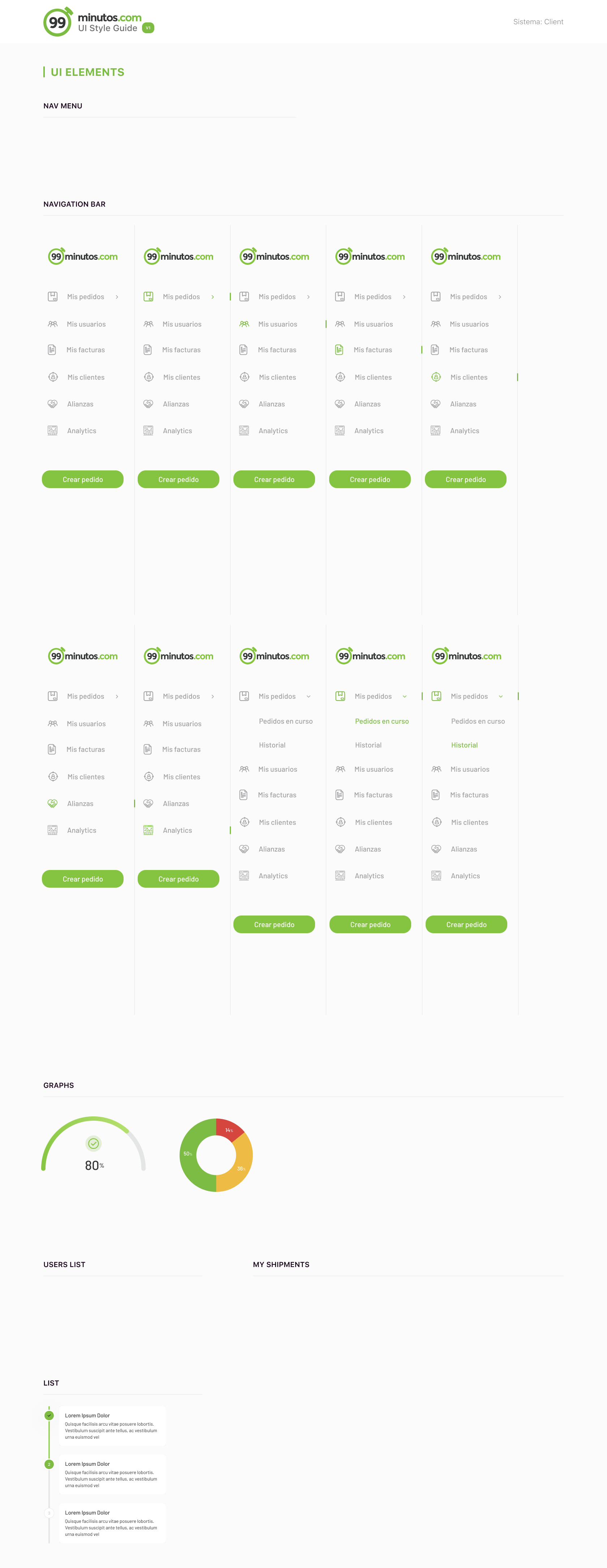
99 Tracker
99 Tracker provides a way to visualize and control the delivery through a mobile-responsive and adaptive website using
geo-location and GPS services to update status and location for user’s convenience.
Duration
8 Weeks
My Role
Research
UX Design
IxD Design
Visual Design
Prototyping
Tools
Figma
Adobe Xd
Adobe PS
Adobe AI
Team
Enrique Alfaro (CTO)
Maryjose Torres (Web Dev)
Viridiana Trujillo (Product Designer)
“How might we provide information of deliveries for end-customers improving the delivery service experience? ”
00. context
99 Minutos is a last mile delivery service currently handling a vast majority of Mexican e-commerce deliveries — a great opportunity to enhance the delivery experience.
I was given the opportunity to work with 99 Minutos engineering and product team to envision the creation of this new platform. I worked alongside my PM to architect and deploy this project.
01. understanding
Benchmarking and API Research:
To understand similar services on the market, user expectations and other nuances, I did competitive studies, analyzed their UVPs, helpful features, and common user complaints.
This clients UVP (99 Minutos) is the ability to track in real-time an “immediate” e-commerce delivery.
Challenges 99 Minutos had before 99 Tracker:
65% of deliveries weren't successfully completed
Due to lack of communication with the end-user, the delivery status was unknown and therefore, not received.Lack of trust and reliability
The only communication channel was poorly designed giving it an unofficial feel and because of this, was not used.Unclear information and information absence
The information provided on the emails wasn’t focused on user needs rendering useless and unimportant to them.
User testing and synthesis:
I conducted a user survey, evaluating and interviewing 50 individuals within our target demographic of 18–45-year-olds on their online shopping habits, preferences, and process.
I found out that:
12% Understood the emails sent were to visualize the status of their deliver
18% Clicked and navigated to the status presenting page
86% Confused the official made mails with spam or scams at least once
10% Find the status presenting page clear to read and easy to follow.
78% Found odd and frustrating the inability to communicate with couriers.
Insight generation:
To determine priorities, pain points and opportunity areas, I organized user findings on an affinity map and reached out to the Product Manager to gain some insights into current business KPIs. In an attempt to combine the solution for end-users and business requirements, I mapped a matrix to locate where priorities felt in regards to one another.
02. key points to target
End-users need to track delivery on real-time
“I’m so used to follow my delivery on UberEats, I expect it to work similar since they are handing me goods as well” — Participant 3
Communication needs to happen to coordinate deliveries
“I once lost a package delivery just because I couldn’t communicate to my courier that there was a roadwork on my street” — Participant 25
Notifications about the process are needed for successful deliveries
“I thought the email they (99 Minutos) sent me was a scam ‘cause of the poor design. I ignored it and never knew my package was sent my way” — Participant 35
03. solutions
Lo-Fi Wireframes
After reviewing my research, I translated finalized ideas into Lo-Fi wireframes and built clickable prototypes (email and interface) for validation testing.
One of the biggest challenges we had was — stakeholders didn’t believe the communication existing emails needed more than a redesign but re-create them. Our stakeholders believed that engineering capacity would be wasted and they preferred pushing resources into only the tracker platform. However, our validation testing proved that 80% of the users were confused or simply dismissive about the emails. Stakeholders then agreed to direct resources into the mailing design.
04. design
99 Minutos had a signature color that guided most of the branding decisions but lacked a style guide or visual identity. I decided to retain the main accent color and created UI elements, to express a consistently design style.
This was the beginning of discussions with PM and the CTO to develop a style guide that unified all the other products under the clients ownership. I did develop such style guide and even coded a bit on the CSS allowing me to have more control on consistency and matching comps.





05. validation
We conducted validation testing of the mobile and desktop clickable prototype with 30 users. Below is a summary of the findings:
99% Found the product easy to use, and clear to navigate.
100% Understood how to contact the courier.
90% Understood the status of the package without any confusion.
90% Found the email redesign more trustworthy and effective,
84% Would recommend the service to a friend.
This solution was implemented on 2019 and increased the delivery success rate by 158%.
0.6 personal takeaways
The solution should always be based on users’ needs and pain points
As this was one of my first projects where I was a lead, trying to come up with a really ‘wow’ solution was on my mind. It was easy for me to rely on my imagination and my aesthetics more than on the research. I felt my ambition was driving me away from the actual solution and I didn't want this project to turn into a vanity project.
I took my first designs created under ideation process and tore them apart trying to match every feature with the pain points and business KPIs. They didn’t comply as well as I wanted them to. So I revisited my research and try to read more upon delivery services to get a bigger scope.
After that pause, everything started running smoothly and fast, I was able to articulate my design decisions and reflect them in the final product.
This project taught me that we as designers should separate from our ego, and know we can benefit from participatory processes and lear a lot from people who don’t wear our ‘designer’ label.
Curious about the whole project?






